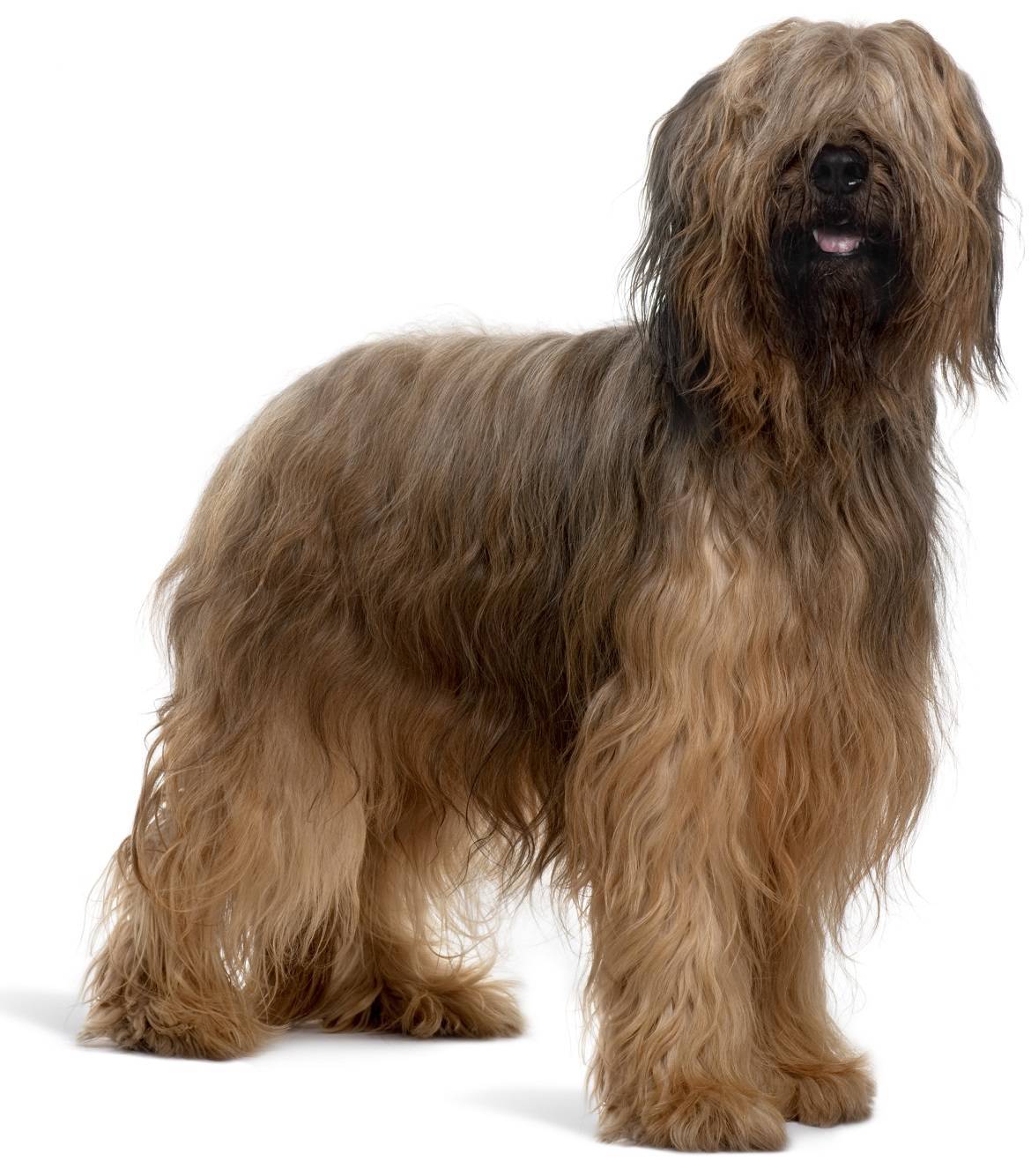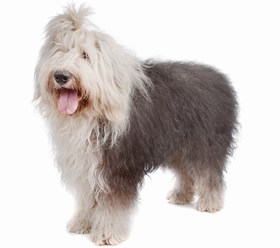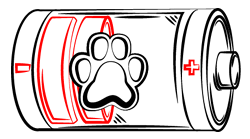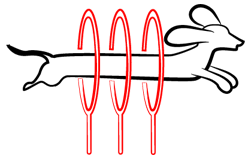
Paws ‘N’ Pups Quickview
Size
| Energy Level
| Trainability
| Paws ‘N’ Pups Rank
|
Characteristics
| Physical Characteristics: Height: 22-27” Weight: 50-100 lbs. Energy Level: Moderate | Colors: The American Kennel Club recognizes the Briard in the following colors:
|
Health & Longevity
Average Life Span: 10-14 years
The Briard is a healthy breed. However, as with all dog breeds, there are a few health problems that can affect the Briard Dog.
Hip dysplasia, one of the most common of canine ailments, impacts some Briards. Hip dysplasia occurs when an abnormal hip joint results in the thighbone not fitting correctly in place. It leads to problems like discomfort, pain, limping, and, in more severe cases, arthritis or even lameness. Hip dysplasia is degenerative and may require surgery in severe cases. Although it is hereditary, it can be triggered by excessive weight gain or injury, such as a fall on a slippery floor.
The Briard is somewhat prone to a serious condition called gastric torsion, or bloat. Bloat is when the stomach fills with gas, fluid, or food, putting increased pressure on the dog’s organs. In some cases, this causes the stomach to flip, trapping blood in the stomach and blocking supply to the lungs, heart, and digestive system. Bloat can be deadly, so get your Briard to the veterinarian if you notice symptoms like pale gums, pacing, a rapid heartbeat, failed attempts to vomit, weakness, drooling, or a swollen stomach.
Although rarely, some Briards may be affected by Progressive Retinal Atrophy (PRA). Dogs affected by this condition will experience degeneration of the retina, which can progress to failed daytime vision. There is no treatment for PRA, but vision loss occurs gradually, allowing the dog an adjustment period, and most dogs affected by PRA maintain a good quality of life.
Hypothyroidism and Von Willebrand’s disease are being found in increasing numbers of Briard Dogs. Hypothyroidism occurs when the thyroid gland does not produce sufficient amounts of hormones, resulting in issues like hair loss, lethargy, obesity, and infertility. Fortunately, hypothyroidism can be treated, although treatment will require daily medication for the lifetime of the affected dog. Von Willebrand’s disease is a blood-clotting disorder caused by insufficient amounts of the protein that binds platelets together. Dogs with Von Willebrand’s disease may bleed heavily and uncontrollably, even from a minor injury. This disease is treated with transfusions of fresh frozen plasma.
In some cases, Briard Dogs may also experience various heart problems.
Overall, this is a healthy breed with an average lifespan of 10-14 years.
Temperament & Train-ability
The Briard Dog is confident, loyal, and incredibly loving. He is a calm, athletic herding dog who loves to play and is very smart. He is sensitive and does not like tension or fighting in the home.
Briards should not live in apartments. Farm life, where he could live as a herding dog and have plenty of space to roam, would be ideal for this breed. A house with a large, fenced-in yard is also sufficient, as long as he has space to run around and stretch his legs. Although a yard to play in is highly recommended for a Briard, he should be an inside dog. He loves companionship and wants to spend time with his family. He is an active dog and should have plenty of time to walk, run around outdoors, and play. If he gets bored or does not exercise adequately, the Briard Dog can become very destructive.
The Briard Dog is generally good with children, but remember that he is a herding dog. As a result, he does try to “herd” people and other animals by pushing and prodding them with his head, which could potentially be an issue with a small child. This behavior will need to be discouraged and can be addressed through training. The Briard is aloof with strangers and needs early socialization to ensure he becomes neither shy nor aggressive. Some do tend to spook easily, but they make excellent guard dogs who will go to great lengths to protect their families. This breed can get along with other animals if raised with them, but they may be aggressive with dogs of the same sex, and they will likely have the instinct to chase and attack cats or other small animals.
Training a Briard Dog requires a confident and consistent hand. They are an independent breed who like to do things their way, so they will need to be taught that you are in charge. Still, they are extremely sensitive and need to be treated gently and respectfully. They have excellent memories and will not quickly forget treatment they perceive as wrong or unfair. They are highly intelligent and learn quickly if properly trained. Use positive reinforcement techniques like favorite treats, extra playtime, and verbal praise.
Grooming
The Briard Dog has a long double coat that can become matted very easily and requires daily brushing (or at least two hours of brushing per week). You will also need to comb and brush his beard, because it can easily become dirty or wet and hold particles of food, etc.
The amount of shedding for this breed varies, but all Briars do shed to some extent. Regular brushing can keep shedding to a minimum. It is also needed to keep the coat clean and prevent the Briard from shedding dirt and debris onto your floors or carpets.
Bathe your Briard Dog as needed. Trim his nails any time they grow long enough to reach the floor and check his ears regularly for signs of infection like redness, tenderness, or odor.
Diet
Feed your Briard Dog a premium brand of dry dog food, preferably one containing meat and/or fruits. Avoid foods with grain or gluten in large quantities, and consider supplementing your Briard’s diet with real meat like chicken or steak. Feed your dog multiple small meals daily.
Remember that the Briard Dog is prone to bloat, so take preventative measures. Do not let your dog eat too rapidly, do not let him drink excessive amounts of water right before or right after eating, and wait at least an hour after eating before allowing him to exercise or be overly active.
Ensure that clean, fresh drinking water is always available for your Briard.
Looking for a Briard?
 Find A Briard Breeder |  Briard Puppies For Sale |  Adopt A Briard |
Cost
This breed is relatively rare, with less than 300 Briard puppies registered in the United States annually. You may have to spend some time on a waiting list before being matched with your puppy. On average, you should expect to pay $1,000-$2,000, although some breeders may offer a lower price. Prices will vary according to breeder location, gender, pedigree, and whether the dog is considered pet quality or show quality.
If you find a Briard Dog to adopt, plan for adoption fees to cost up to $175.
Paws ‘N’ Pups Ranking
Paws ‘N’ Pups ranks every breed out of 4 with 1 being easiest to integrate into your life and 4 being the toughest – The lower the ranking the better.
Ranking takes into account a few basic factors including cost, skill level needed, high vs low maintenance and how critical regular training is to success. The Briard Dog ranks a 3. He is a healthy dog who is loyal, loving, and an excellent protector of his family. He does need socialization; he can be wary of strangers, aggressive towards dogs and other animals, and may attempt to herd animals and people alike. Additionally, he is somewhat challenging to train and requires daily brushing.
Breeds Similar To Briard
 Belgian Sheepdog |  Polish Lowland Sheepdog |  Old English Sheepdog |  Shetland Sheepdog |




